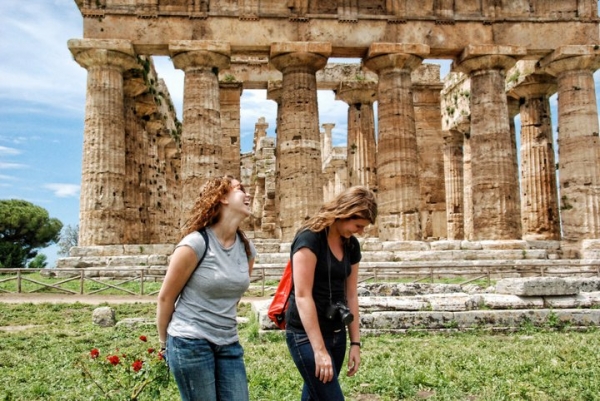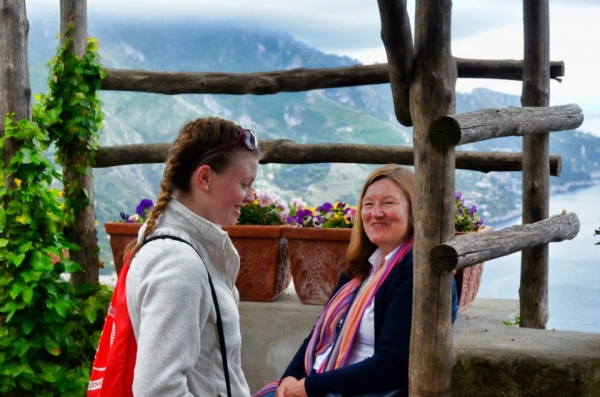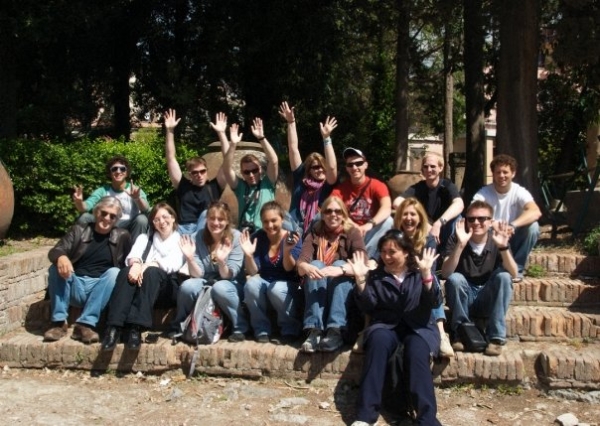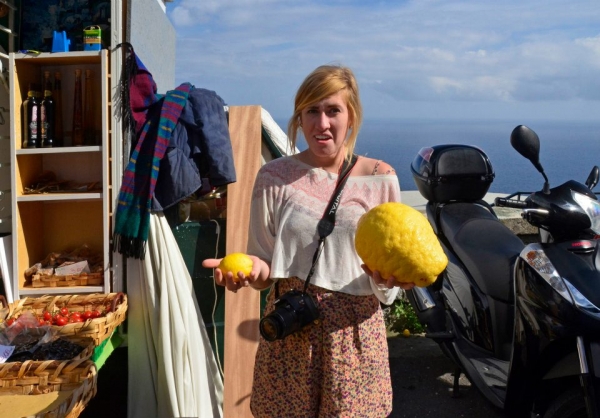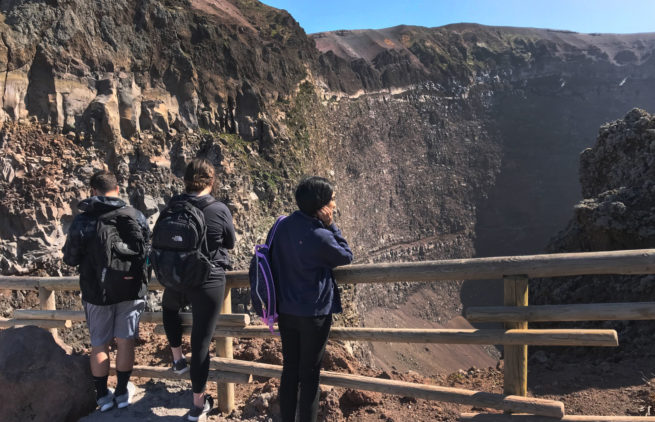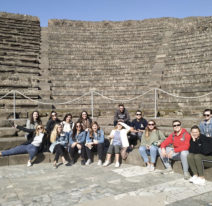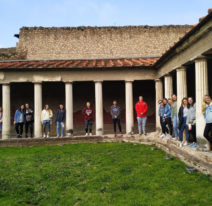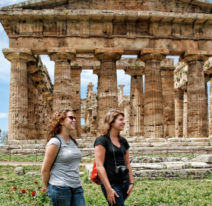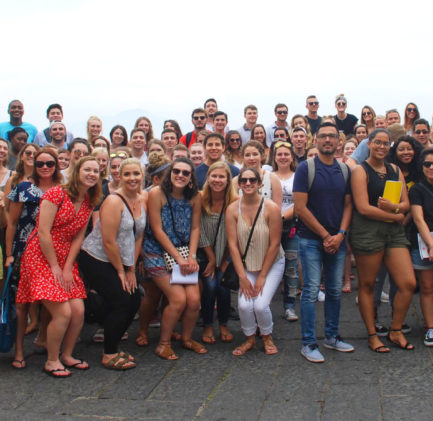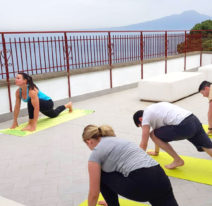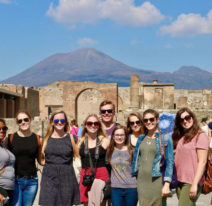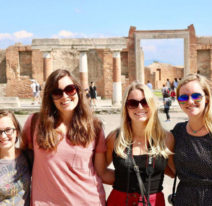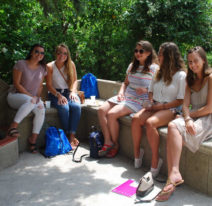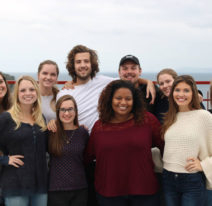COURSES
Greek 101 is the introductory course in which you will learn the simplest grammatical concepts and proceed step by step to the more difficult. The Greek course is designed to help you develop proficiency in writing and especially reading Ancient Greek. Such a goal means that you will acquire certain linguistic knowledge and skills (e.g. pronunciation, vocabulary, morphology and syntax), but it also means that you need to understand the culture that produced texts in Greek and used it on a daily basis. Third, it means that you will learn not only to observe, abstract, and analyze linguistic and cultural information, but also to synthesize it and to put it into the historical context. No prior knowledge of grammar or any other language except English is required. All technical terms will be explained and illustrated when they first appear.
In Greek 101, we will cover Chapters 1-10 of Athenaze. Upon successfully completing this course, students will be able to read and understand selections from classical texts and demonstrate a knowledge of inflections, grammatical constructions, and vocabulary items found on the average page of a classical literary text. Proficient at reading ancient Greek prose and poetry at an elementary level. Students will be also able to deduce the meaning of English words that are derived from Greek. Conversant with key aspects of ancient Greek language and culture. practiced at thinking critically about key aspects of ancient Greek language and culture. Relate Greek language and culture to the modern world. Skillful or more skillful reflecting constructively on their own learning processes.
The value of a liberal-arts education is primarily humanistic and intellectual, not practical. As part of this training they acquire fundamental techniques of inquiry, logical analysis, and literary interpretation. In Classics courses students study the cultures of Greece and Rome, which founded and shaped all of Western civilization, become acquainted with the world at large and learn that the past is always present and important. The study of Latin is one of the best
(because proven over two millennia) foundations to prepare students for all these aspects of the liberal arts. Latin courses train students to think logically and analytically, to become aware of and learn how to use grammar and sentence structure, the necessary basis for clear and accurate expository writing and speaking, and to increase their English vocabulary.
Latin 101 (Elementary Latin I) provide students with a proficiency-oriented immersion in beginning Latin which is geared primarily toward reading comprehension. Emphasis is on the thorough study of the fundamentals of grammar (morphology and syntax) and vocabulary. Students study basic grammar and learn the essential elements of Latin pronunciation in order to be able to read simple passages in Latin. They read aloud La.n passages that have been modified for comprehension. The relationship between English and Latin is emphasized in vocabulary building, word derivation, and meanings of prefixes and suffixes. Essential vocabulary and language structures are presented to students within the context of the themes and topics.
The course offers a historical framework to understand the Greek presence in western Europe: the sites colonized starting from the 8th century B.C., and the dynamics that caused the foundation of poleis in specific areas of the Italian peninsula. Magna Graecia is the collective name for the Greek cities of Southern Italy. A worth premise is that Greek civilization and identity crystallized not when Greeks were close together but when they came to be far apart. It emerged during the Archaic period when Greeks founded coastal city states and trading stations in ever-widening horizons from the Ukraine to Spain. No center directed their diffusion: mother cities were numerous and the new settlements (“colonies”) would often
engender more settlements. The “Greek center” was at sea; it was formed through back-ripple effects of cultural convergence, following the physical divergence of independent settlements. The course focuses on the history of the Mediterranean as seen from a variety of perspectives, including Phoenician, Greek and Roman.
Through the analysis of foundation myths (supported by archaeological remains in different sites), students will understand the “colonial urge” towards western Europe; They will be able to compare
the interpretations of this phenomenon given by ancient (Greek and Roman) sources and the historical, political and economic situation which lead populations to colonize other areas. Moreover, students will understand the cultural and artistic development and the various transformations of colonies (due to the contacts with Italic populations), by studying the poleis and their territories.
45 hrs, 3 credits
COURSE DESCRIPTION
In this course, you will explore the religions of ancient Greek and Roman society from their earliest beginnings to the end of paganism and the emergence of Christianity. You will try to understand questions such as: How did Greeks and Romans conceptualize the divine and their relationship to it? How was ancient religion actually practiced? How does religion relate to myth and ritual? How did religion and politics interrelate? What exactly were the alternatives to civically practiced religion that modern cultures call “mystery cults?” Who were the critics of ancient religions, and what was the substance of their criticisms? What was the distinction between magic and religion? These fundamental questions (and many others) will occupy your thoughts in this course. While this class follows a broadly chronological outline, individual lectures concentrate on specific themes, such as forms and places of worship, philosophy and religion, death and afterlife, magic and the concept of conversion. This course is designed to introduce the tenets, beliefs, and certain spiritual practices of Classical antiquity and to investigate the social, cultural, and political background of which ancient religion was part. In this class, you will benefit from attending your study abroad program in Sorrento, in the middle of ancient Magna Graecia. On-site lessons in Paestum and Pompeii will be organized throughout the course of the semester.
45 contact hrs, 3 credits
Elementary Latin II provides students with a proficiency-oriented immersion in beginning Latin which is geared primarily toward reading comprehension.
Emphasis is on the thorough study of the fundamentals of grammar (morphology and syntax) and vocabulary. During this class students will gain a mastery of the first principles of Latin grammar that they have studied in Elementary Latin I. Students will also study the Latin syntax in order to be able to read quite complex sentences in Latin. The relationship between English and Latin is emphasized in vocabulary building, word derivation, and meanings of prefixes and suffixes.
More advanced vocabulary and language structures are presented to students within the context of the themes and topics.
45 hrs, 3 credits
Prof. Ilaria Tartaglia
COURSE DESCRIPTION
Archaeology studies past cultures and societies through their material remains. This course provides a basic introduction to the discipline, focusing on the study of some major Roman cities destroyed by the eruption of Vesuvius in 79 AD. The program combines the archaeological study with analysis of the historical, economic, and social aspects of the Roman culture of the era. Students participate in several site visits to examine the remains and reconstruction of the ancient cities.
Student Learning Outcomes
At the end of the course the student will be able to:
- Know the history of the eruption of Vesuvius in 79 AD and its consequences
- Understand the characteristic features of Latin civilization (i.e. economy and society) of the second century
- Analyze the importance of the archaeological heritage of cities such as Pompeii and Herculaneum
Faculty
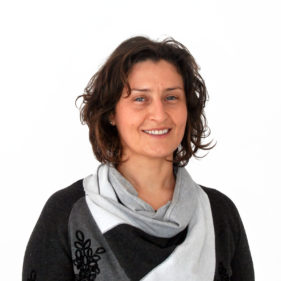
Ida Brancaccio
Chair of Classical Studies - Area: Classical StudiesIlaria Tartaglia
ArchaeologyOur Mission
Sant'Anna's mission is to educate, support, and inspire international students to become active citizens of the world. We are committed to academic excellence within an authentic and engaging Italian community.Discover Sant'Anna
Mission and GoalsAt Sant’Anna we strive to provide students from across the world a unique, hands-on learning experience where they can cultivate real world skills and knowledge.
Because the school is located in Sorrento, one of the most harmonious cities southern Italy has to offer, our students are truly able to gain a global awareness and appreciate diversity while studying abroad. Our goal is to help guide participating students into becoming responsible, open-minded members of society.
Our hope is that each student can leave Sant’Anna with an appreciation of the Italian culture as well as the knowledge acquired through their academic courses.
We are so passionate about the importance of international education and training in a student’s academic career, and we are dedicated to doing whatever it takes to providing students with a life changing experience.
Warning: Undefined array key "title" in /web/htdocs/www.santannainstitute.com/home/wp-content/plugins/builderpress/inc/elements/general/grid-images/tpl/layout-1.php on line 29
Warning: Undefined array key "title" in /web/htdocs/www.santannainstitute.com/home/wp-content/plugins/builderpress/inc/elements/general/grid-images/tpl/layout-1.php on line 29
Warning: Undefined array key "title" in /web/htdocs/www.santannainstitute.com/home/wp-content/plugins/builderpress/inc/elements/general/grid-images/tpl/layout-1.php on line 29
Warning: Undefined array key "title" in /web/htdocs/www.santannainstitute.com/home/wp-content/plugins/builderpress/inc/elements/general/grid-images/tpl/layout-1.php on line 29
Learning
Mediterranean Location
Our LocationWhy choose Sorrento?
Study abroad programs in Italy have traditionally focused on the popular cultural centers of Rome, Florence, Milan, and other cities in the north of Italy. At Sant’Anna Institute, study abroad students have the opportunity to experience the unique culture, customs, and climate of southern Italy.
Sant’Anna is located in the stunning town of Sorrento at the beginning of the Amalfi Coast, just 20 miles south of Naples. Perched atop hundred foot cliffs that face the Gulf of Naples, Sorrento is within sight of rugged snow-capped mountains, emerald waters, black sand beaches, cliff- hanging villages, and the world’s best known volcano: Vesuvius.
Sorrento is a safe, walkable, and picturesque center of international tourism. It has an international population, making it a small town, with a cosmopolitan feel.
Sorrento also boasts:
- Friendly, gracious people
- Southern hospitality
- Italian style
- Bustling shopping streets and traditional Roman-style alleys
- A mild, sun-drenched Mediterranean climate
- Culinary traditions based on the seafood, and locally grown, fresh produce
- Streets lined with lemon and orange trees
- Hillsides covered with olive groves and vineyards
- Home to some of the best pizza and gelato you will find anywhere
Sorrento is a treasure all its own and a passageway to the:
- tunning islands of Capri and Ischia
- baroque splendor of Naples
- majestic Greek temples at Paestum
- historic Roman ruins of Pompeii and Herculaneum
- world-famous collection at the National Archaeological Museum in Naples
- cliff hanging villages of the Amalfi Coast, like Positano, Amalfi and Ravello
- world’s best known volcano, Mount Vesuvius
It’s the perfect city to discover a home away from home with a hometown feel!
Sant’Anna Institute is located overlooking the Marina Grande of Sorrento, perched on the cliffside with stunning views from the sea-facing windows, and it’s a short walk to the harbor and the harbor-side restaurants.
The Institute is located a short 15-minute walk from the center of town and 20 minutes from the Sorrento train and bus station.
The Residence Hall was established in 2017 and is on the third and fourth floors of the Institute, overlooking the picturesque Marina Grande.




